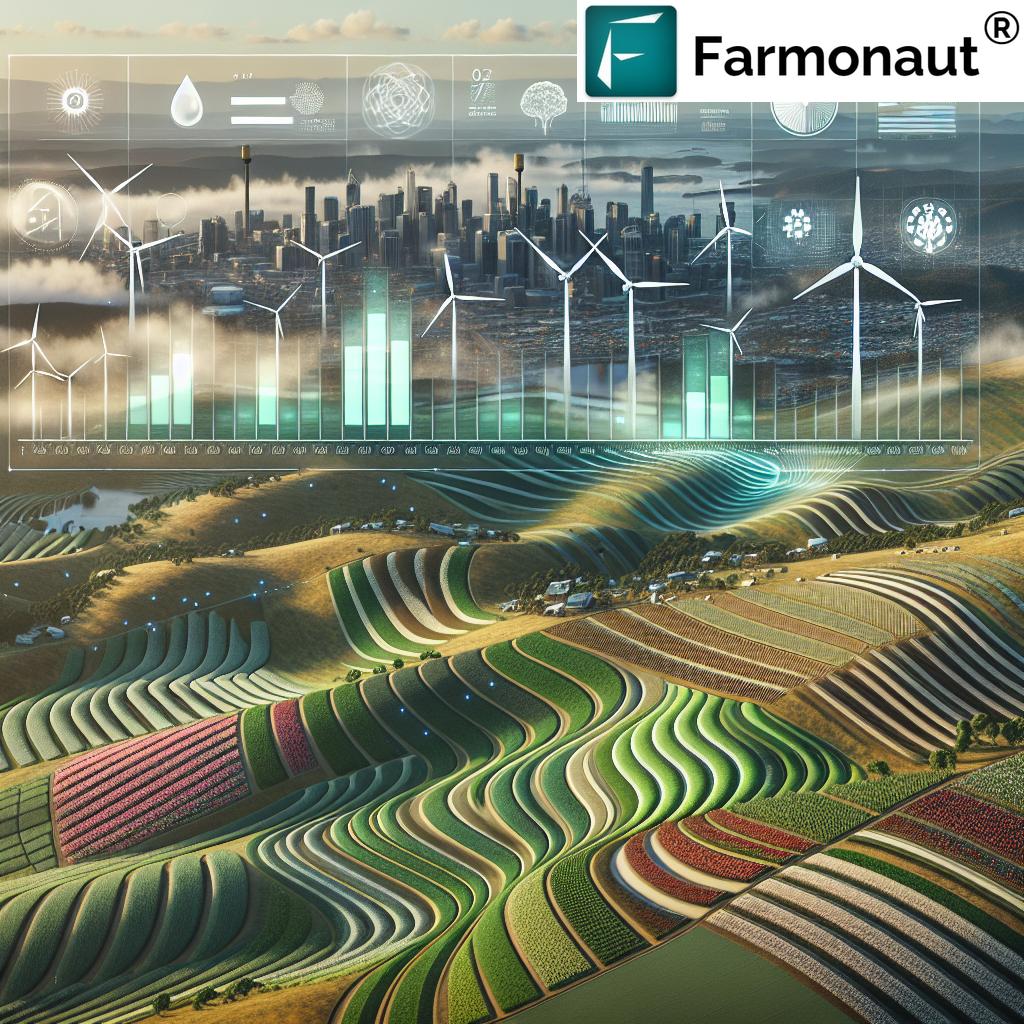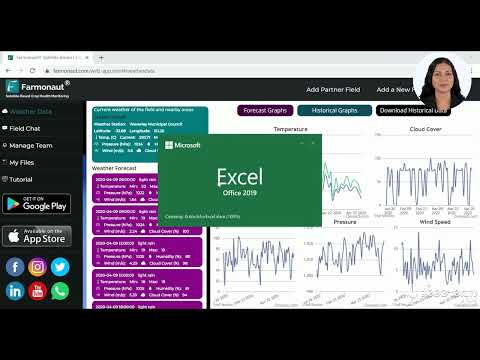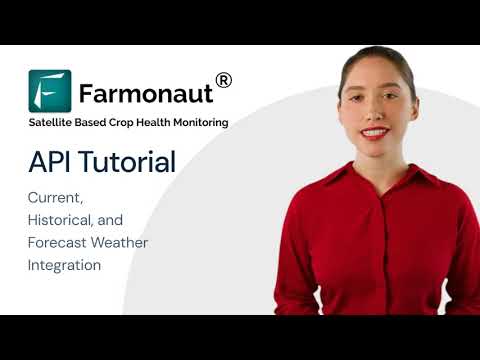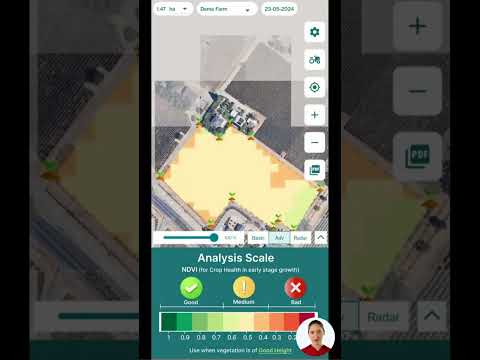Weather-Based Crop Planning: Farmonaut’s Guide to Climate-Smart Farming in Sydney
“Sydney’s Collaroy Beach experiences temperatures between 14°C to 17°C today, with strong southerly winds affecting crop planning.”
Welcome to Farmonaut’s comprehensive guide on weather-based crop planning and climate-smart farming techniques for Sydney’s agricultural community. As pioneers in precision agriculture tools and weather forecasting for agriculture, we’re excited to share our latest insights on leveraging agricultural meteorology and satellite-based crop monitoring to enhance your farming practices.
Today, we’ll focus on the weather conditions at Collaroy Beach, Sydney, and explore how this data can inform your agricultural decisions. Let’s dive into the world of agtech weather solutions and discover how they can revolutionize your farm management strategies.
Today’s Weather Forecast for Collaroy Beach, Sydney
Before we delve into the intricacies of climate-smart farming, let’s take a look at today’s weather forecast for Collaroy Beach:
- Conditions: Cloudy with a high chance of showers
- Temperature Range: 14°C to 17°C
- Wind: Strong southerly winds
This current weather data serves as a perfect example of how daily forecasts can impact your farming decisions. Let’s explore how you can use this information to your advantage.
The Importance of Weather Forecasting for Agriculture
Weather forecasting for agriculture is a crucial aspect of modern farming practices. It allows farmers to make informed decisions about planting, irrigation, pest control, and harvesting. By integrating weather data into your farm management software, you can optimize your operations and increase crop yields.
At Farmonaut, we understand the significance of accurate weather predictions for agriculture. Our platform combines satellite imagery with advanced weather forecasting models to provide you with precise, location-specific data.

Crop Weather Monitoring: A Key to Success
Crop weather monitoring is an essential component of precision agriculture. It involves tracking various weather parameters that directly affect crop growth and development. These include:
- Temperature
- Precipitation
- Humidity
- Wind speed and direction
- Solar radiation
By closely monitoring these factors, you can make timely decisions to protect your crops from adverse weather conditions and optimize their growth potential.
Leveraging Precision Agriculture Tools for Weather-Based Crop Planning
Precision agriculture tools have revolutionized the way farmers approach crop planning. These tools allow for the collection and analysis of vast amounts of data, enabling more precise and efficient farming practices. Here’s how you can leverage these tools for weather-based crop planning:
- Satellite-Based Crop Monitoring: Utilize satellite imagery to assess crop health and growth patterns across your fields.
- Weather Stations: Install on-farm weather stations to collect localized data for more accurate predictions.
- Soil Moisture Sensors: Monitor soil moisture levels to optimize irrigation schedules based on weather forecasts.
- Crop Models: Use crop growth models that incorporate weather data to predict yields and potential issues.
Farmonaut’s platform integrates these precision agriculture tools, providing you with a comprehensive solution for weather-based crop planning.
Agricultural Weather Data: The Foundation of Informed Decision-Making
Agricultural weather data forms the backbone of climate-smart farming. This data goes beyond simple temperature and precipitation forecasts, encompassing a wide range of parameters that affect crop growth and farm operations. Key components of agricultural weather data include:
- Growing Degree Days (GDD)
- Evapotranspiration rates
- Frost and heat stress indices
- Wind chill factors
- UV radiation levels
By analyzing this comprehensive data set, farmers can make more accurate predictions about crop development stages, pest and disease pressures, and optimal timing for various farm activities.
Integrating Weather Data into Farm Management Software
To truly harness the power of agricultural weather data, it’s essential to integrate it into your farm management software. This integration allows for:
- Automated alerts for critical weather events
- Customized recommendations based on crop type and growth stage
- Historical data analysis for long-term planning
- Real-time updates to adjust daily farm operations
Farmonaut’s farm management software seamlessly incorporates weather data, providing you with actionable insights at your fingertips.
“Farmonaut’s weather forecasting for agriculture covers multiple factors, including UV index and fire danger ratings, for comprehensive farm management.”
Climate-Smart Farming: Adapting to Changing Weather Patterns
Climate-smart farming is an approach that helps farmers adapt to changing weather patterns while reducing greenhouse gas emissions and increasing productivity. It involves three main pillars:
- Adaptation: Developing resilient farming systems that can withstand climate variability.
- Mitigation: Reducing greenhouse gas emissions from agricultural activities.
- Productivity: Increasing agricultural productivity and incomes sustainably.
By embracing climate-smart farming techniques, Sydney’s farmers can ensure long-term sustainability and profitability in the face of changing weather patterns.

Weather-Based Crop Planning: A Step-by-Step Guide
Now that we’ve covered the importance of weather data in agriculture, let’s walk through a step-by-step guide to weather-based crop planning:
- Assess Your Local Climate: Understand the typical weather patterns in your area, including seasonal variations and extreme weather events.
- Choose Suitable Crops: Select crops that are well-adapted to your local climate and can withstand potential weather challenges.
- Create a Planting Schedule: Use weather forecasts and historical data to determine optimal planting dates for each crop.
- Implement Irrigation Strategies: Develop irrigation plans based on precipitation forecasts and crop water requirements.
- Plan for Pest and Disease Management: Anticipate pest and disease pressures based on weather conditions and prepare preventive measures.
- Optimize Fertilizer Application: Time fertilizer applications to coincide with favorable weather conditions for maximum efficacy.
- Prepare for Extreme Weather: Develop contingency plans for extreme weather events such as heatwaves, frosts, or heavy rains.
- Monitor and Adjust: Continuously monitor weather conditions and crop performance, adjusting your plans as needed.
By following these steps and utilizing Farmonaut’s precision agriculture tools, you can create a robust weather-based crop planning strategy for your farm.
Agricultural Meteorology: Understanding the Science Behind Weather Forecasts
Agricultural meteorology is a specialized field that focuses on the impact of weather and climate on agricultural systems. It combines meteorological data with agricultural knowledge to provide tailored forecasts and recommendations for farmers. Key aspects of agricultural meteorology include:
- Microclimate analysis
- Crop-specific weather indices
- Seasonal climate predictions
- Agroclimatic zoning
By understanding the principles of agricultural meteorology, farmers can better interpret weather forecasts and apply them to their specific farming contexts.
Satellite-Based Crop Monitoring: A Game-Changer for Precision Agriculture
Satellite-based crop monitoring has revolutionized precision agriculture by providing farmers with a bird’s-eye view of their fields. This technology offers several advantages:
- Large-scale coverage of agricultural areas
- Regular and consistent data collection
- Early detection of crop stress and diseases
- Accurate yield predictions
- Historical data for long-term analysis
Farmonaut’s satellite-based crop monitoring system integrates seamlessly with our weather forecasting capabilities, providing you with a comprehensive tool for precision agriculture.
Explore Farmonaut’s satellite-based crop monitoring system: 
Agtech Weather Solutions: Innovations in Agricultural Forecasting
The field of agtech weather solutions is rapidly evolving, with new innovations constantly emerging. Some of the latest developments include:
- AI-powered weather prediction models
- Hyperlocal forecasting using IoT sensors
- Blockchain-based weather data sharing
- Machine learning algorithms for crop-specific weather impact analysis
These advancements are making weather forecasts more accurate, timely, and relevant for agricultural applications.
Renewable Energy Applications in Weather-Based Farming
Weather-based crop planning also intersects with renewable energy applications in agriculture. By leveraging weather forecasts, farmers can optimize the use of renewable energy sources such as:
- Solar power for irrigation systems
- Wind energy for farm operations
- Biomass energy from crop residues
Integrating renewable energy into your farming practices not only reduces costs but also contributes to sustainable agriculture.
UV Index and Fire Danger Ratings: Critical Factors for Sydney Farmers
For farmers in Sydney, two additional weather factors require special attention: UV index and fire danger ratings.
UV Index
The UV index is particularly important in Australia due to the country’s high levels of solar radiation. High UV levels can affect both crops and farm workers. Consider the following:
- Use UV-resistant crop varieties when possible
- Implement shading techniques for sensitive crops
- Ensure proper protection for farm workers during high UV periods
Fire Danger Ratings
Given Australia’s susceptibility to bushfires, monitoring fire danger ratings is crucial for farm safety and crop protection. Farmonaut’s weather forecasting includes fire danger ratings to help you:
- Implement fire prevention measures during high-risk periods
- Develop evacuation plans for livestock
- Protect valuable farm assets and crops
Access Farmonaut’s comprehensive weather data through our API: Farmonaut API
International Agriculture: Applying Climate-Smart Techniques Globally
While our focus today has been on Sydney, the principles of climate-smart farming and weather-based crop planning are applicable worldwide. Farmonaut’s solutions are designed to support international agriculture, with coverage extending to:
- Oceania
- Africa
- South America
- Asia
- South East Asia
- Central America
- Europe
- Middle East
- North America
By adapting these techniques to local conditions, farmers around the world can benefit from precision agriculture and weather-based crop planning.
Weather Forecast Comparison for Collaroy Beach, Sydney
| Date | Temperature Range (°C) | Precipitation Chance (%) | Wind Speed (km/h) | UV Index |
|---|---|---|---|---|
| Today | 14 – 17 | 80% | 30 – 40 | 3 (Moderate) |
| Tomorrow | 15 – 18 | 60% | 25 – 35 | 4 (Moderate) |
| Day 3 | 16 – 20 | 40% | 20 – 30 | 5 (Moderate) |
| Day 4 | 17 – 21 | 20% | 15 – 25 | 6 (High) |
| Day 5 | 18 – 22 | 10% | 10 – 20 | 7 (High) |
| Day 6 | 17 – 21 | 30% | 15 – 25 | 6 (High) |
| Day 7 | 16 – 20 | 50% | 20 – 30 | 5 (Moderate) |
This forecast comparison table provides a week-long outlook for Collaroy Beach, Sydney. Use this information to plan your agricultural activities, adjusting your strategies based on the expected weather conditions.
Farmonaut’s Commitment to Climate-Smart Farming
At Farmonaut, we’re dedicated to empowering farmers with the tools and knowledge they need to thrive in an ever-changing climate. Our comprehensive platform offers:
- Real-time weather forecasts and alerts
- Satellite-based crop health monitoring
- AI-powered agricultural advisory services
- Integration with farm management software
- Access to historical weather and crop data
By leveraging these tools, you can make informed decisions that optimize your crop yields while minimizing environmental impact.
Explore Farmonaut’s mobile apps for on-the-go farm management:
Conclusion: Embracing Weather-Based Crop Planning for a Sustainable Future
As we’ve explored throughout this guide, weather-based crop planning is essential for modern, climate-smart farming. By leveraging precision agriculture tools, agricultural weather data, and satellite-based crop monitoring, farmers in Sydney and beyond can adapt to changing weather patterns and optimize their agricultural practices.
Farmonaut is committed to supporting farmers in this journey towards sustainable and profitable agriculture. Our comprehensive suite of tools and services is designed to provide you with the insights you need to make informed decisions, no matter the weather conditions.
As you implement these strategies on your farm, remember that weather-based crop planning is an ongoing process. Continuously monitor, analyze, and adjust your approaches to ensure the best outcomes for your crops and your farm’s sustainability.
FAQs
- How often does Farmonaut update its weather forecasts?
Farmonaut provides real-time weather updates, with forecasts typically refreshed multiple times per day to ensure accuracy. - Can Farmonaut’s system be integrated with my existing farm management software?
Yes, Farmonaut offers API access that allows for seamless integration with many farm management software systems. - How accurate is satellite-based crop monitoring?
Satellite-based crop monitoring can be highly accurate, often detecting issues before they’re visible to the naked eye. However, ground-truthing is still recommended for best results. - Does Farmonaut provide support for organic farming practices?
Yes, Farmonaut’s tools and insights can be applied to both conventional and organic farming practices, supporting sustainable agriculture across various methods. - How can I get started with Farmonaut’s weather-based crop planning tools?
You can start by signing up for a Farmonaut account and exploring our web or mobile applications. Our team is also available to provide guidance and support as you implement these tools on your farm.
For more information on our services and to start your journey towards climate-smart farming, visit our website or contact our support team. Together, we can build a more resilient and productive agricultural future for Sydney and beyond.
Ready to revolutionize your farming practices? Explore Farmonaut’s subscription options:
For developers interested in integrating Farmonaut’s weather and satellite data into their own applications, check out our API Developer Docs.
By embracing weather-based crop planning and leveraging Farmonaut’s advanced tools, you’re taking a significant step towards more sustainable, efficient, and profitable farming. Let’s work together to create a brighter future for agriculture in Sydney and around the world.





